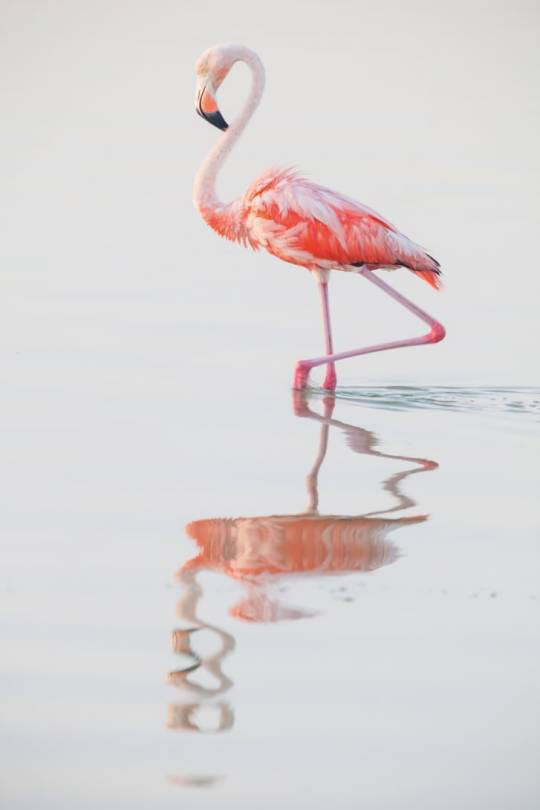#claudio contreras koob
Photo
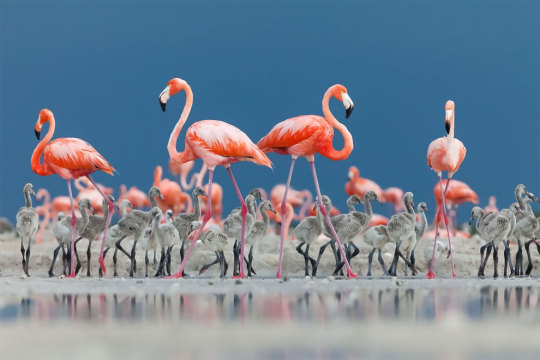
A breeding colony of Caribbean, or American, flamingos, in Ría Lagartos biosphere reserve, on the Yucatán Peninsula, Mexico.
Photo by Claudio Contreras Koob
Wildlife Photographer of the Year
#claudio contreras koob#photographer#wildlife photographer of the year#breeding colony#bird photography#caribbean flamingos#american flamingos#ria lagartos biosphere reserve#yucatan peninsula#mexico#animal#nature
51 notes
·
View notes
Photo

“Caribbean crèche” by Claudio Contreras Koob, Mexico.
8 notes
·
View notes
Link
3 notes
·
View notes
Text

Among the Flowers. Martin Gregus watched this polar-bear cub playing in a mass of fireweed on the coast of Hudson Bay, Canada. Every so often, the cub would take a break from its fun, stand on its hind legs, and poke its head up above the high flowers to look for its mother. © Martin Gregus/Wildlife Photographer of the Year

A Golden Huddle. Two female and one male golden snub-nosed monkey huddle together to keep warm in the extreme winter cold. Threatened mainly by forest loss and fragmentation, this endangered species is confined to central China. Restricted to living high up in the temperate forests, these monkeys—here in the Qinling Mountains, in Shaanxi province—feed mostly in the trees, on leaves, bark, buds, and lichen. © Minqiang Lu/Wildlife Photographer of the Year

Caribbean Crèche. Claudio Contreras Koob was lying down on the mud a safe distance from a breeding colony of Caribbean, or American, flamingos, in Ría Lagartos Biosphere Reserve, on the Yucatán Peninsula, Mexico. It was June, and the flamingo chicks had already left their nests and were in crèches. These crèches are always guarded by adult birds, so when the chicks began to approach Koob, the adults surrounded them and gently led them back to the colony. © Claudio Contreras Koob/Wildlife Photographer of the Year

Head to Head. The spectacle of two female musk oxen attacking each other surprised Miquel Angel Artús Illana. For four days, he had been following a musk-ox family in Norway’s Dovrefjell-Sunndalsfjella National Park—a male, a female, and three calves. On a beautiful high plateau, another similar-size family of musk ox appeared. Expecting a male head-to-head (it was September and the females were in heat), he was disappointed when the two males came to an immediate understanding and the weaker one backed off. It was then that the two females began their short but intense fight. © Miquel Angel Artús Illana/Wildlife Photographer of the Year

Red and Yellow. Near Rausu port, on the Japanese island of Hokkaido, several hundred glaucous-winged gulls waited for the return of fishermen. It was the beginning of March and freezing, and the air was full of the raucous calls of the gulls overhead. Some of the birds began to settle, keeping their eyes on the horizon. Focusing on one bird, Chloé Bès composed a minimalist portrait, highlighting the eye and the beak. The red spot on the beak develops when gulls are adult and is in part a reflection of their health. © Chloé Bès/Wildlife Photographer of the Year

Holding On. This leopardess had killed a monkey in Zambia’s South Luangwa National Park. The monkey’s baby was still alive and clinging to its mother. Igor Altuna watched as the predator walked calmly back to her own baby. Her cub played with the baby monkey for more than an hour before killing it, almost as if it had been given live prey as a hunting lesson. © Igor Altuna/Wildlife Photographer of the Year

World of the Snow Leopard. Against a backdrop of the spectacular mountains of Ladakh in northern India, a snow leopard has been caught in a perfect pose by Sascha Fonseca’s carefully positioned camera trap. Thick snow blankets the ground, but the big cat’s dense coat and furry foot pads keep it warm. Fonseca captured this image during a three-year bait-free camera-trap project high up in the Indian Himalayas. © Sascha Fonseca/Wildlife Photographer of the Year

In a Flap, Queensland, Australia 🇦🇺! ‘The far eastern curlew is the largest migratory shore bird in the world, and is listed as critically endangered in Australia. They start their life in Russia and north-eastern China before flying to Australia, where they rely on the intertidal mudflats for food and habitat. This image was taken in Wellington Point, Queensland, three hours before the high tide.’ Photograph: Manoj Kutty Padeettathil Manilal
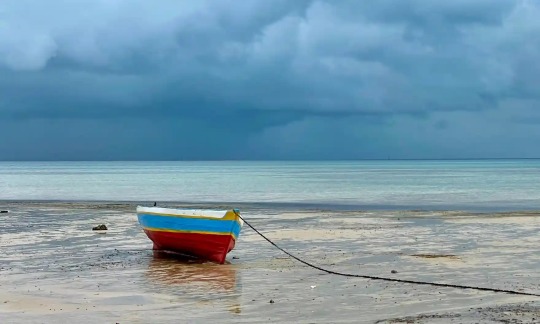
Storm Brewing, Mozambique 🇲🇿! ‘Rainy skies closing in on a local fisherman’s boat on Bazaruto Island, Mozambique.’ Photograph: Terry Dunnem
0 notes
Text
New Study Shows Smithsonian People-Focused Conservation Initiatives Benefit Society and Nature To Support Life on a Sustainable Planet
New Study Shows Smithsonian People-Focused Conservation Initiatives Benefit Society and Nature To Support Life on a Sustainable Planet
Credit: Claudio Contreras-Koob / International League of Conservation Photographers (iLCP)
New research published recently in the journal Conservation Science and Practice shows conservation work led by Smithsonian researchers brings tangible benefits to local communities, government agencies and the private sector as well as the environment in the United States and in countries across the…

View On WordPress
0 notes
Text
The secret life of flamingos: the conservation photographer capturing mesmerizing images of Mexico's iconic bird
The secret life of flamingos: the conservation photographer capturing mesmerizing images of Mexico’s iconic bird
Written by Rebecca Cairns, CNN
Since he was four years old, photographer Claudio Contreras Koob has been obsessed with flamingos: their vibrant pink feathers, horn-like curved beaks, and elegant, poised necks.
Born and raised in Mexico City, Koob visited the Yucatán Peninsula every year during school holidays. His father built a house on sand dunes in the port village of Chuburná, between the…
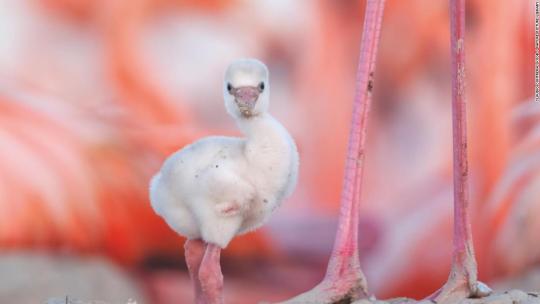
View On WordPress
0 notes
Text
The secret life of flamingos: the conservation photographer capturing mesmerizing images of Mexico's iconic bird
The secret life of flamingos: the conservation photographer capturing mesmerizing images of Mexico’s iconic bird
Written by Rebecca Cairns, CNN
Since he was four years old, photographer Claudio Contreras Koob has been obsessed with flamingos: their vibrant pink feathers, horn-like curved beaks, and elegant, poised necks.
Born and raised in Mexico City, Koob visited the Yucatán Peninsula every year during school holidays. His father built a house on sand dunes in the port village of Chuburná, between the…

View On WordPress
#Arts#The secret life of flamingos: the conservation photographer capturing mesmerizing images of Mexico&x27;s iconic bird - CNN
0 notes
Link

Photographer Claudio Contreras Koob
THESE dazzling photos showcase one of the world’s most distinctive birds: the flamingo. Taken by biologist and photographer Claudio Contreras Koob, the images are a selection from his new photography book, Flamingo, which captures the lives of colonies in the Yucatán peninsula in Mexico.
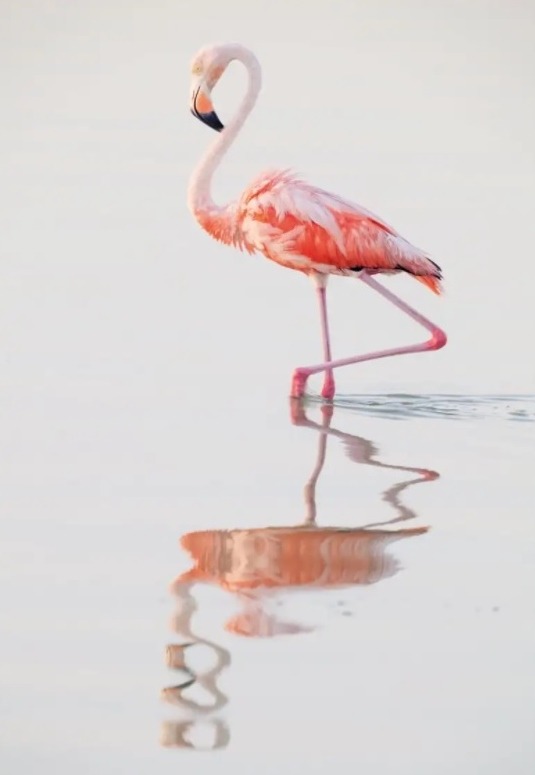
Claudio Contreras Koob is a multi-award winning photographer and a member of the International League of Conservation Photographers. Prior to his photography career, which spans over two decades, he studied biology at the National Autonomous University of Mexico. His most recent photographic expedition has been spent in Socorro Island in Mexico, where he has documented many endemic species.
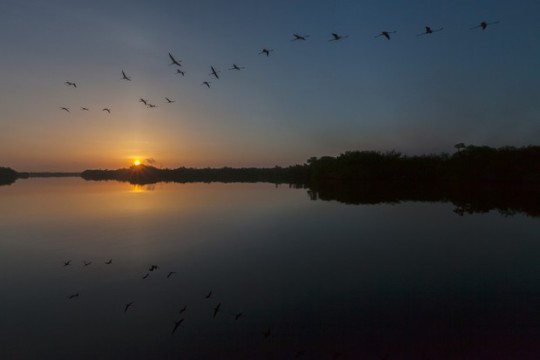
About Flamingo
Flamingo is the first photo book to exclusively cover these fascinating birds. This beautiful book showcases the beauty of flamingos, from incredible close-up detail, to panoramic images that show the scale of the colonies against the wild backdrop of Ría Lagartos river delta on the Yucatán Peninsula.
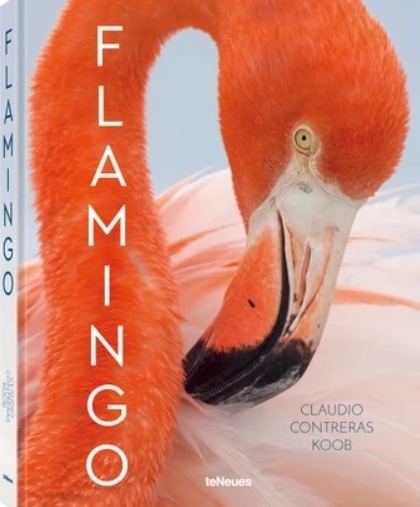
None of these shots would have been possible without the knowledge and patience of Contreras Koob, who spent more than 10 years building the trust of the flamingo colony in order to get close enough to photograph them at the different stages of their lifecycle. The resulting images are an accurate portrayal of flamingos behaving naturally and undisturbed in the wild.
Playing with colour, light, form and movement, Contreras Koob’s images capture small and intimate moments in the lives of these special birds, sometimes amusing, sometimes endearing, and always beautiful.
The photographs taken by Contreras Koob are a love letter to this unique bird that combines in-depth expertise with an artistic aesthetic.

Although there are an enormous number of flamingos, the vastness of the wetlands in Yucatán makes it difficult to track them and predict where they will land.
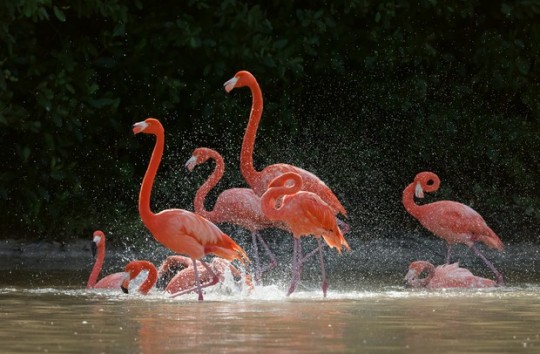
The Celestún estuary is a popular place for flamingos and is near the cenotes, underwater water reservoirs that inject fresh water into the middle of a lagoon as if from a spring.
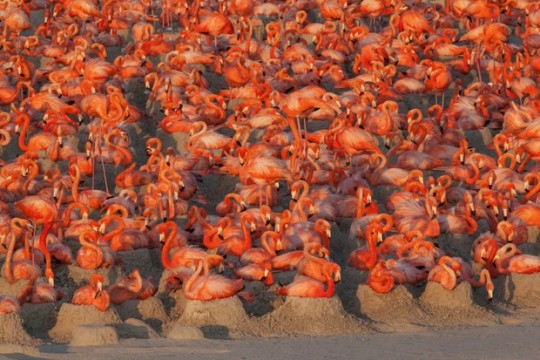
To incubate their eggs, flamingos build nesting sites in their colonies. They consist of mud cones that must be constantly maintained so that rising water doesn’t wash away the eggs.

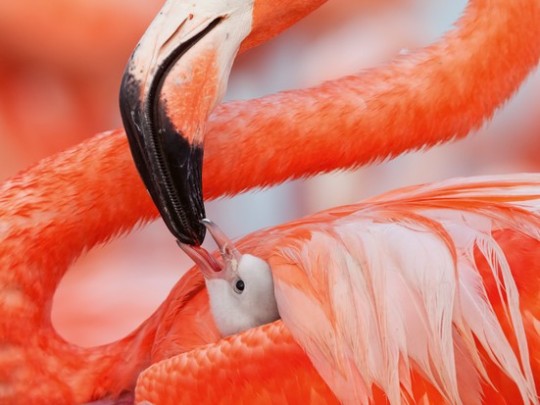
The fluid that feeds the nestling is called crop milk. Both adults produce this secretion in the upper part of the intestine.
As they grow, the chicks begin to explore the surroundings of the colony, always under the watchful eye of several adult animals who look after them.
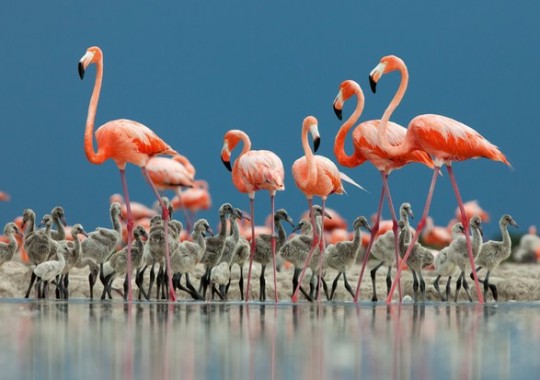
#🇲🇽#Claudio Contreras Koob#mexican photographers#STEM#biology#biologist#mexican#animal#mexico#flamingo#books#yucatan#yucatan mexico#International League of Conservation Photographers#National Autonomous University of Mexico#Ría Lagartos river delta#Celestún estuary
2 notes
·
View notes
Photo

Caribbean Flamingos in the Yucatan Peninsula in Mexico
Photographer: Claudio Contreras Koob
#claudio contreras koob#photographer#caribbean flamingos#flamingos#bird photography#bird chick#yucatan peninsula#mexico#nature
213 notes
·
View notes
Photo

Grooming the descendant by Claudio Contreras Koob, Mexico
‘This fluffy Caribbean flamingo chick is less than five days old and is being preened by one of its parents in the Ría Lagartos biosphere reserve, Yucatán, Mexico. Chicks remain in the nest for less than a week; they then wander around the colony in crèches and start to feed for themselves, although their parents still continue to feed them for several months. The flamingo colony is highly sensitive to human presence, so Claudio could only approach the colony on all fours while hiding underneath a camo throw-over.’
Photograph: Claudio Contreras Koob/Natural History Museum
#nature#wildlife#animals#grooming the descendant#flamingo#birds#descendant#claudio contreras koob#mexico#fluffly#caribeean#caribbean flamingo#chick#baby#mother#transparent#love#parents#family#ria lagartos biosphere reserve#reserve#biosphere#ria lagartos#conservations#yucatan#nest#colony#independent#hiding#photographer
7 notes
·
View notes
Text
A New Book Illuminates the Lives of the Elusive, Pink-Plumed Flamingos in Mexico’s Yucatán Peninsula
A New Book Illuminates the Lives of the Elusive, Pink-Plumed Flamingos in Mexico’s Yucatán Peninsula
Photography
#birds
#books
The fluid that feeds the nestling is called crop milk. Both adults produce this secretion in the upper part of the intestine. All images © Photo © Claudio Contreras Koob and Nature Picture Library, shared with permission
In the Yucatán Peninsula, the rich wetland environment of the Ría Lagartos Biosphere Reserve is one of the most important sites for flamingos. The…
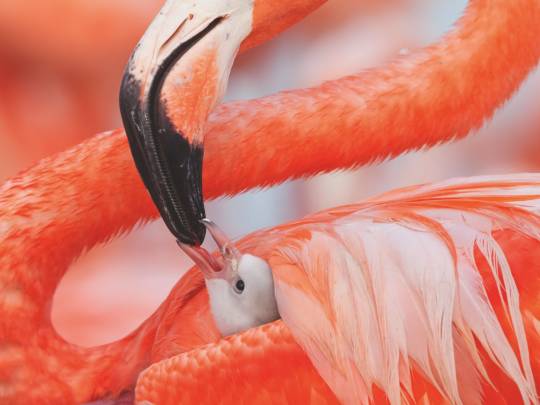
View On WordPress
#&#artist#book#elusive#flamingos#illuminates#learn#lives#mexico’s#peninsula#pink-plumed#skills#yucatán
4 notes
·
View notes
Link
Click/tap the caption to see the photos published by Smithsonian. Here are some of them:

Mountain Gorillas, Volcanoes National Park, Rwanda by Nelis Wolmarans (Winner, Grand Prize): "I was humbled sitting in such close proximity to the powerful female as she lay with this tiny bundle of fur in her arms." (© Nelis Wolmarans, courtesy of Nature's Best Photography Windland Smith Rice International Awards)

Bull Moose, Grand Teton National Park, Wyoming, USA by Isaac Spotts (Youth Photographer of the Year): "Cautiously, I slid into the water to be eye-level with them." (© Isaac Spots, courtesy of Nature's Best Photography Windland Smith Rice International Awards)
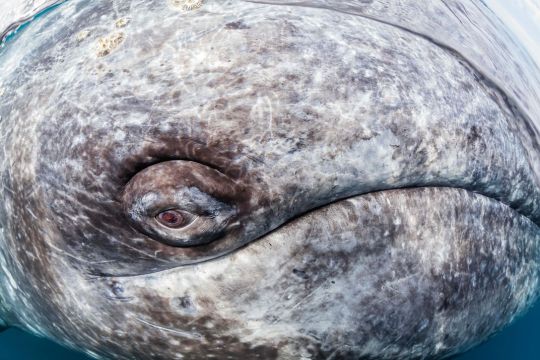
Gray Whale, Magdalena Bay, near San Carlos, Baja California Sur, Mexico by Claudio Contreras Koob (Winner for "Ocean Views"): "Every winter, gray whales embark on an enormous migration from the freezing waters of the Arctic to the mild coastal lagoons of central Baja California." (© Claudio Contreras Koob, courtesy of Nature's Best Photography Windland Smith Rice International Awards)

Burchell’s Zebras, Near Okaukuejo Camp, Etosha Wildlife Park, Namibia by Catherine Dobbins d’Alessio: "As they held that position, I wondered whether it was a challenge for a fight or just a friendly gesture." (© Catherine Dobbins d’Alessio, courtesy of Nature's Best Photography Windland Smith Rice International Awards)
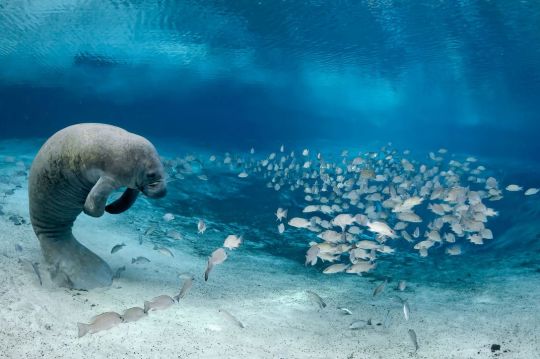
Florida Manatee, Crystal River National Wildlife Refuge, Florida, USA by Carol Grant: “Is this manatee communing with the fish? Only it knows for sure." (© Carol Grant, courtesy of Nature's Best Photography Windland Smith Rice International Awards)
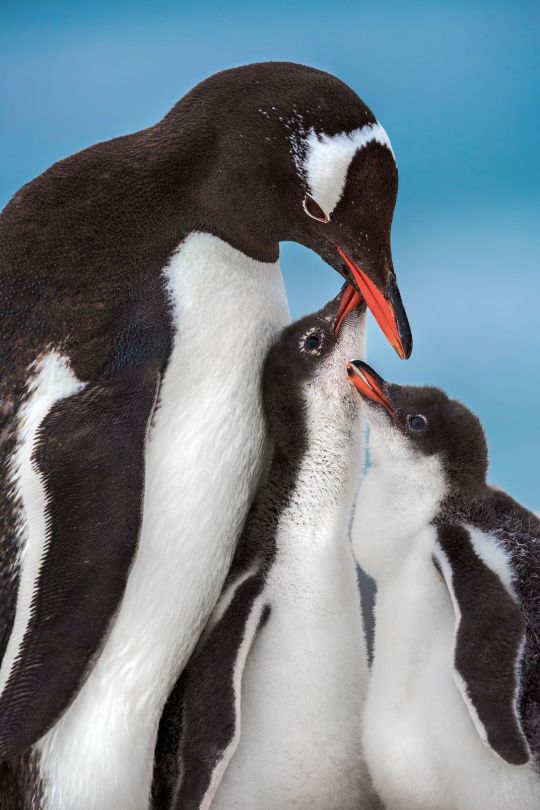
Gentoo Penguins, Antarctic Peninsula by Anil Sud: "I spotted two chicks being fed by their parent." (© Anil Sud, courtesy of Nature's Best Photography Windland Smith Rice International Awards)
7 notes
·
View notes
Photo
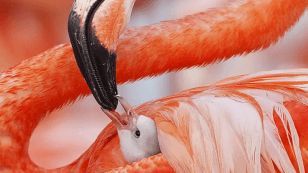
«Flamingo» λεύκωμα από τον φωτογράφο Claudio Contreras Koob https://ift.tt/bAPVhEX
0 notes
Text
Animal Science: Before They Grow Into Splendor, Flamingos Are Just Awkward Floofs! Take A Photographic Journey Through The Yucatán's Busiest Flamingo Nursery.
— By Claudio Contreras Koob and Martha A. Salaza | May 2, 2022

“Soon I see a white head peek out of the orange plumage. I imagine that this little creature must think the whole planet is orange". Claudio Contreras Koob/NaturePl.Com
As spring draws to a close, the long wait finally ends with the birth of thousands of flamingos. To document this sensitive process, I had to approach the sandy islet where the birds had settled in complete darkness. From the shore, the murmur of the colony was barely audible, but loud enough for me to estimate that the population was situated some 800 meters away from me, an assessment that I managed to confirm as soon as I crossed the water and mud to reach the islet. Once there, I was surrounded by a plethora of noise.
Crouching down, I sneaked over to a small dune that gave me enough cover to prepare for my final approach. With my equipment ready and myself in camouflage, I crawled as low to the ground as I could towards the birds. Halfway there, I paused, waiting for more light so that I could see the backlit silhouettes of the flamingos, showing me if I could approach and whether they were aware of my presence. If a single flamingo stood up from its nest, that would tell me that it didn’t feel safe, so I would have to stop and retreat. From that point on, I proceeded very slowly and carefully—at no point did I want to disturb the colony.
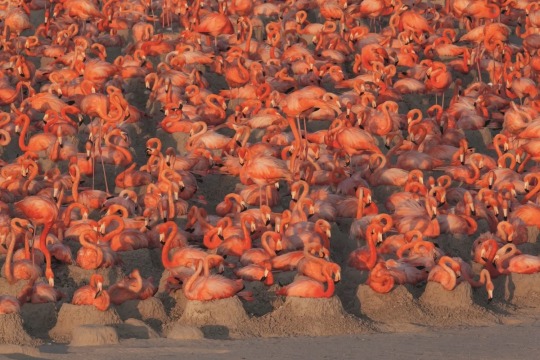
To incubate their eggs, flamingos build nesting sites in their colonies. They consist of mud cones that must be constantly. Claudio Contreras Koob/naturepl.com
My patience paid off: by sunrise, I found myself relatively close to the nests. The adults were busy preening their feathers, starting the new day quite relaxed. The cacophony of the colony was deafening. Suddenly, an adult sitting on a nest began to stir strangely, as if something was bothering it. It composed itself and returned to sitting on the nest. As it adjusted itself, I could see a small, white head trying to peer out through the orange feathers. Surrounded by a sea of orange consisting of about 15,000 nests, I imagined that this little creature must have thought that the world was orange.
Frail and curious, the chick managed to stick out its beak. The tip of its beak was a little lighter: it was the egg tooth, a small protrusion used specifically to breakthrough the shell and it would disappear soon after hatching. The chick quickly moved on to the most important activity of its short life: it begged for food from anyone who was around. Through my telephoto lens, I could see it asking for food. Despite my distance from the nest and through all the excitement around me, I could make out the adult being called by the nestling; each flamingo has a unique screech by which adults and their young can identify each other within a colony.

The fluid that feeds the nestling is called crop milk. Both adults produce this secretion in the upper part of the intestine. Claudio Contreras Koob/naturepl.com
The adult responded by holding the chick’s head between its wing and body, while at the same time, moving its neck and jaw to regurgitate food for its young. Coordination was not easy for the nestling when it could barely hold its head up, but when both beaks managed to touch, I could see a red liquid pouring from the tip of one into the other, as if life itself was being passed from parent to offspring.
The red fluid that fed the nestling is called crop milk. Both adults produce this secretion in the upper part of the intestine. Incredibly, after only a few days of having been fed the crop milk, the chick was wandering around the nest, flapping its little, white down-covered wings, while the adult desperately tried to keep it within the borders of its nest.
This phase is the most dangerous in the life of a flamingo, because although its legs are thick and provide it with good support, the chick itself is very unstable. After barely five days of its life in the nest, it is bored and wants more freedom to roam, but the parents know that a fall from the nest can cause it to break a leg or a wing, thus endangering its chances of survival.
The next morning, I waited in the same spot for the sun to rise. Earlier on, I could sense a subtle but constant movement from within the colony: it was the adults’ turn to leave the nest. All together they moved slowly forward, preening at times, along the same route. With each stride, they traversed avenues invisible at ground level, until they reached the colony’s edge. From there, they would take off in search for food. I was also fortunate to witness the reverse process: the adults returning to the colony, entering and disappearing into the orange labyrinth with the knowledge of the exact whereabouts of their own offspring.
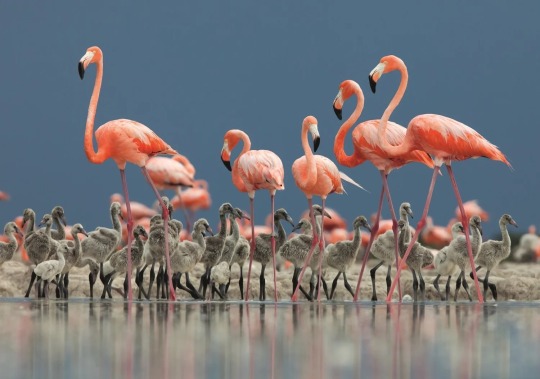
As they grow, the chicks begin to explore the surroundings of the colony, always under the watchful eye of several adult animals who look after them. Claudio Contreras Koob/naturepl.com
A few days later, I returned to the same spot and saw one of the adults trying to contain its increasingly adventurous nestling by holding it between the legs with its beak, trying to force it to sit down. In the end, what the adult had tried so hard to prevent happened anyway: The nestling made it to the edge of the nest. It took a big step towards freedom, and rolled down the mud walls to the ground.
Luckily, everything turned out well: the chick was upside down on the ground, but it was okay. It quickly sat up and began to explore its surrounding world with its beak. It discovered pebbles, small shells and pieces of eggshell as it wandered around the alleys that separated its nest from those of its neighbors. Everything was new for the young animal. For the first time, its legs experienced the sensation of wading through water; something this bird will do for the rest of its life. Finally having satisfied its curiosity, the chick returned to the nest; or rather it precariously scaled the high, volcano-like walls of the nest using its beak and wings to stabilize itself while pushing upwards with its sturdy, pink legs.
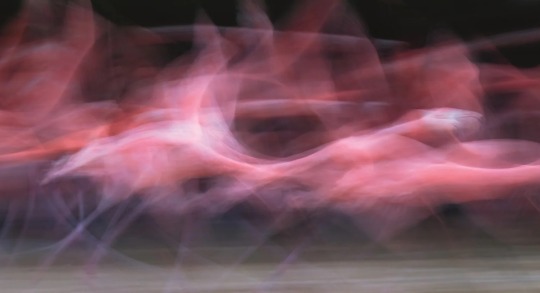
The photographs taken by the nature and conservation photographer are a love letter to this unique bird that combines in-depth expertise with an artistic aesthetic. Claudio Contreras Koob/naturepl.com
At ten days old, the nestling’s restricted life in the nest was over. It left its nest, never to return to it. At that age, when its down feathers were replaced by grey ones, it wanted to wander the clay streets, to explore every little corner of the orange city with its peers, with whom it formed a crèche or nursery. The little members of this nursery mimicked the behavior of the adults: dipping their beaks into the water as if to filter something and moving them from side to side as they waded through the puddles that had formed around the nests in recent days. At one point, the chicks suddenly decided all together to abandon their expedition and take a different route, and this new route led straight to where I was positioned. I didn’t know what I would do when faced with these innocent little birds which were heading towards me. Luckily, the adults in charge of them stepped in just in time and herded them back to the safety of the colony.
Time flew. Almost two months later, there were only a few inhabited nests and the crèche had grown. Those that were previously chicks were now bigger and covered with plumage, and they kept flapping their wings. The more advanced fledglings, on the other hand, were able to fly a few meters above the water before crash-landing.
The parents had to be very patient when it came to feeding the fledglings because their young were insatiable. To show their dissatisfaction, they would circle the adults and scream at them, despite their seemingly submissive posture. They wanted more and when they didn’t get anything, they stamped around angrily in the water. Unsurprisingly, when an adult had no food for its fledgling, it would escape these tantrums in the only way in which it still had an advantage over its young: by flying away.
Unfortunately, I also saw the lonely chicks roaming around with their wings hanging down; the consequences of a hard fall. Because they were no longer able to fly, their growth was obviously slower. Faced with the lack of mobility, they tried to raise their broken wings with the support of a leg, but to no avail; their fates were sealed.
Towards the end of summer, most of the offspring were able to fly and so the young birds dispersed in all directions. In the three years it took them to become adults, they dedicated their time to gaining experience. It is still not clear whether flamingos simply like to travel or if they have been displaced by the experienced adults from areas that are rich in food, but some have been sighted in the United States, the Cayman Islands and Cuba. Throughout that period of time and up to the age of six years when they have their first offspring, they must learn several lessons: the importance of staying close to the breeding grounds, identifying the best foraging areas and acquiring the skills in terms of couple coordination as it has been shown that those who venture into parenting too soon, fail.
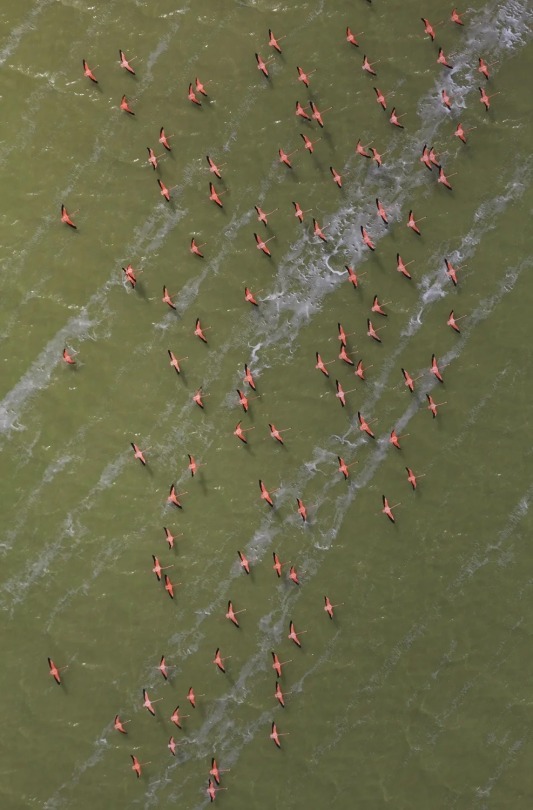
Aerial view of flamingos on Mexico’s Yucatán Peninsula. Claudio Contreras Koob/naturepl.com
The adults in turn leave the colony after the nesting period to regain strength at their preferred feeding areas along the Yucatán coast. In contrast to when they came to settle in the colony, their plumage looks discolored. The whitish coloring on the head, neck and back comes from the fact that the pigments that once made them so beautiful during their stay in the breeding colony were now destined to fulfill other functions, such as an antioxidant, within the body.
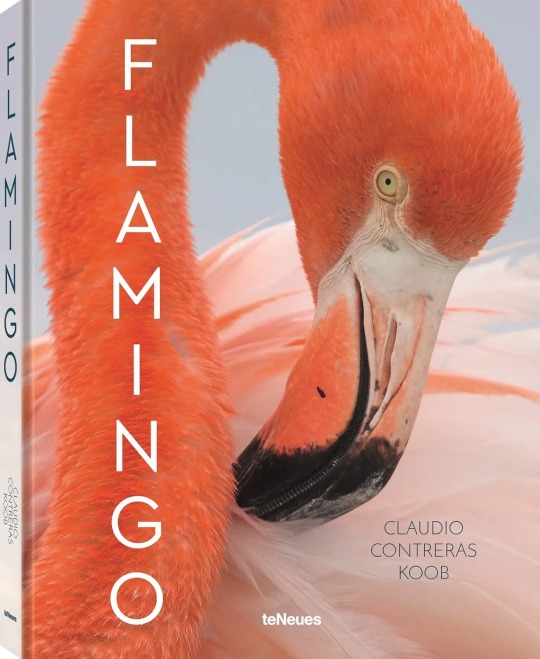
Flamingo by Claudio Contreras Koob Courtesy of teNeues
The day finally came when dawn at the nesting colony was silent; it was strange to be present in the calm after so many months of commotion. The flamingos had left a landscape that resembled something out of a science fiction novel. It felt strange to walk through the alleys which, only until recently, were off-limits, an orange hubbub of noisy activity. Having had the privilege to spend so much time there, it felt bittersweet. On the one hand, walking past the empty nests, I recalled all the birds that had once filled them with life. On the other hand, I could also recall those who had left that one lonely egg in its nest.
If conservation continues to move in the right direction, I know that the calm will be short-lived and also necessary, given the fact that the next surge of colors won’t belong in coming. My greatest wish is that someday, the flamingos will allow me to be with them once again.
— Excerpt and photographs from Flamingo by Claudio Contreras Koob.
0 notes
Text
A New Book Illuminates the Lives of the Elusive, Pink-Plumed Flamingos in Mexico's Yucatán Peninsula | Colossal
A New Book Illuminates the Lives of the Elusive, Pink-Plumed Flamingos in Mexico’s Yucatán Peninsula | Colossal
MAY 6, 2022. GRACE EBERT
The fluid that feeds the nestling is called crop milk. Both adults produce this secretion in the upper part of the intestine. All images © Photo © Claudio Contreras Koob and Nature Picture Library
In the Yucatán Peninsula, the rich wetland environment of the Ría Lagartos Biosphere Reserveis one of the most important sites for flamingos. The pink-pigmented birds flock to…
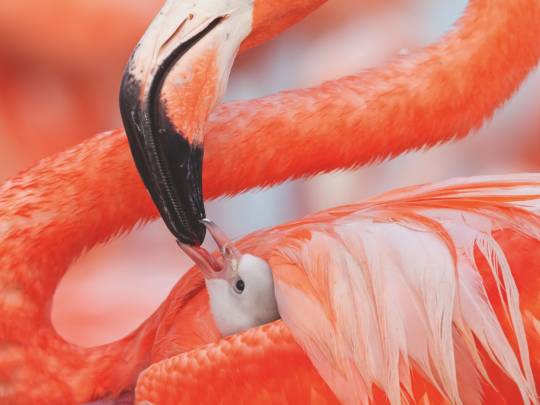
View On WordPress
0 notes
